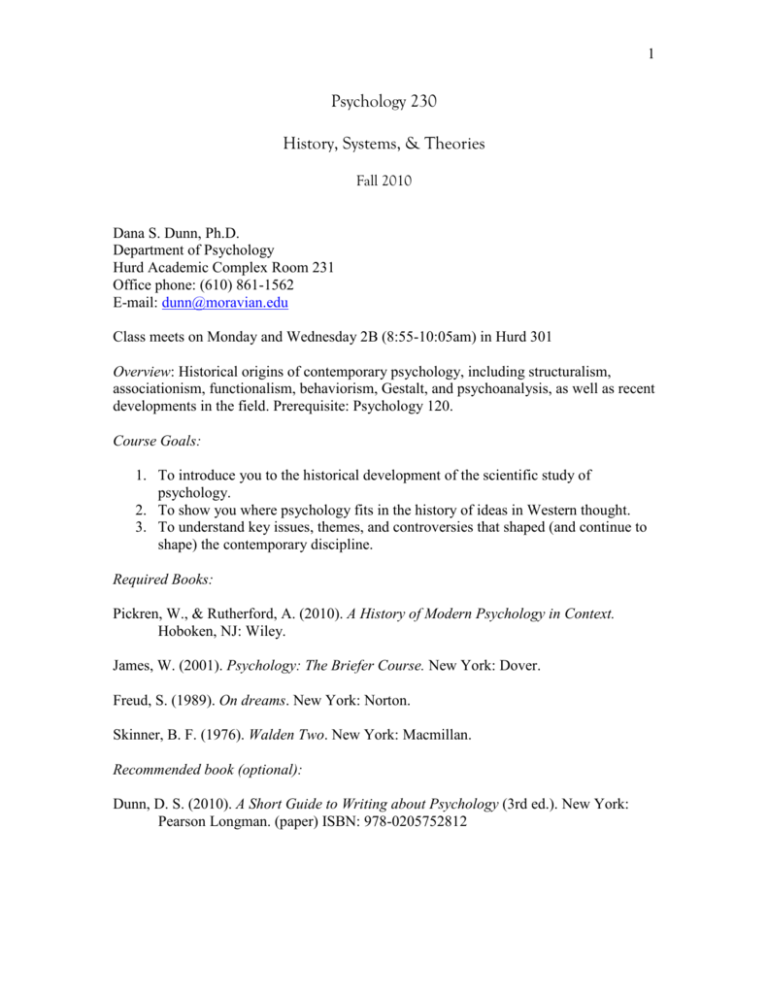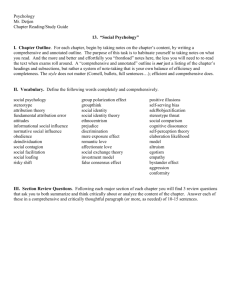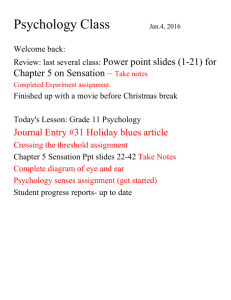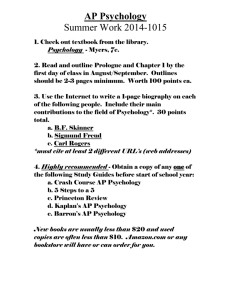
1
Psychology 230
History, Systems, & Theories
Fall 2010
Dana S. Dunn, Ph.D.
Department of Psychology
Hurd Academic Complex Room 231
Office phone: (610) 861-1562
E-mail: dunn@moravian.edu
Class meets on Monday and Wednesday 2B (8:55-10:05am) in Hurd 301
Overview: Historical origins of contemporary psychology, including structuralism,
associationism, functionalism, behaviorism, Gestalt, and psychoanalysis, as well as recent
developments in the field. Prerequisite: Psychology 120.
Course Goals:
1. To introduce you to the historical development of the scientific study of
psychology.
2. To show you where psychology fits in the history of ideas in Western thought.
3. To understand key issues, themes, and controversies that shaped (and continue to
shape) the contemporary discipline.
Required Books:
Pickren, W., & Rutherford, A. (2010). A History of Modern Psychology in Context.
Hoboken, NJ: Wiley.
James, W. (2001). Psychology: The Briefer Course. New York: Dover.
Freud, S. (1989). On dreams. New York: Norton.
Skinner, B. F. (1976). Walden Two. New York: Macmillan.
Recommended book (optional):
Dunn, D. S. (2010). A Short Guide to Writing about Psychology (3rd ed.). New York:
Pearson Longman. (paper) ISBN: 978-0205752812
2
Course Requirements
1.
Class participation and attendance. This course requires constant attendance,
active participation and critical discussion of the readings. I expect that you will
attend each and every class, and that you will come prepared to talk about—and
question—what you read. Class participation is worth 20% of your final course
grade.
Please note that I will be taking role, thus your absence from class will affect your
participation grade (i.e., if you are not in class, you cannot contribute to
discussion). If you miss a class, you are responsible for any material covered,
notes given, announcements, etc. If you are absent, please see one of your
classmates regarding that day's assignments.
2.
Short papers. Two short papers (3-5 pages)—one a dream interpretation exercise,
the other a response to Walden Two—are required across the semester.
These papers are meant to organize your thinking about a topic as well as to spur
class discussion.
Late Paper Policy. You have three written assignments for this class. Hard
copies of all paper assignments are due at the beginning of class or in advance of
the dates listed in the syllabus. Papers submitted later than this time—for any
reason—will be penalized by 20% (i.e., a paper that would have earned a 95 on
time receives a 75) on the first day and 10% each day thereafter (including
weekends), up to 50%. Practically speaking, an A paper that is 5 days late
receives a grade of 50 once it is turned in—if it is never submitted, then it
receives a grade of 0. I will not accept electronic copies of papers sent via email,
only hard copies. Plan accordingly by working ahead and consistently on your
papers.
Submitting work early. I am happy to accept your papers before they are due.
3.
William James Website Project. As a class, we will design and develop materials
for a web site on the influence of ideas from individual chapters in James’s
Psychology: The Briefer Course. You will work with a partner to develop your
materials for the project, which, when finished, will become a resource on the
World Wide Web for people interested in the ideas and influence of William
James. Detailed directions and due dates are provided later in this syllabus.
4.
Exams. Two exams, a midterm and a final exam, will be given. The exams will
be comprised of essay questions requiring you to make use of course materials
and discussions. Each exam will be worth 20% of your final course grade (i.e., 40
% overall). We will discuss the exam formats during class. A missed exam will be
recorded as a Zero (0) grade. Make-up exams will be given at my discretion, and
valid evidence for the absence will be required (e.g., emergency, documented
medical excuse).
3
5.
Grading. Your final course grade will be based on the following percentage
weights:
Class participation and attendance
Midterm Exam
Short papers (10% each)
William James Web Site Project
Final Exam
20%
20%
20%
20%
20%
6.
Plagiarism. Plagiarism is the intentional use of another person’s work,
misrepresenting that work as your own. All outside sources (i.e., any and all ideas
that are not your own) must be properly cited—these include quotations from
books, articles, etc. Having someone write a paper for you, relying on the
course files from a fraternity or a sorority, or purchasing papers from a
“professional” writing service are not acceptable methods for satisfying course
requirements. The Psychology Department requires that students keep notes,
note cards, rough drafts, etc. for papers until a course grade is given. A course
instructor may request the above materials at any time. Plagiarism will be dealt
with in accordance with the new college policy on academic honesty. Please visit:
http://www.moravian.edu/studentLife/handbook/academic2.htm to view the
policy. In short, plagiarism will not be tolerated.
7.
Disability accommodations. Students who wish to request accommodations in this
class for a disability should contact Mr. Joe Kempfer, Assistant Director for
Learning Services for Disability Support, 1307 Main Street (campus extension
1510). Accommodations cannot be provided until authorization is received from
the Office of Learning Services.
8.
Office Hours for fall 2010:
Monday
Wednesday
Friday
1:30pm – 3pm
1:30pm - 3pm
8:30am – 9am; 10- 11:30am
When necessary appointments for other times may be scheduled.
9.
Syllabus. I reserve the right to alter the syllabus if I decide change is necessary.
4
Course Outline
Week One – Organizational Meeting and Course Overview – M Aug 30 & W Sept 1
Begin keeping a dream journal (see attached instructions at end of syllabus)
Read Introduction and Chapter 1 in Pickren & Rutherford (hereafter, P&R)
Week Two – Psychology Before Science – M Sep 6 (No Class Meeting—Labor Day) &
W Sep 8
Look through James’s Psychology: The Briefer Course
(1) Look over the 17 chapter topics
(2) List your top 6 choices (in order)
(3) We will form teams and discuss the web site design project on Wednesday
Week Three – Everyday Life and Psychological Practice – M Sep 13 (No Class Meeting
Today) & W Sep 15
Read Chapter 2 in P&R
Read your team’s project chapter in James and begin the critical analysis paper
Week Four – Subject Matter, Methods, and the Making of a New Science – M Sep 20 &
W Sep 22
Read Chapter 3 in P&R
Bring to class a concrete list of items your team believes the WJ Web Site should
contain – due on Wednesday. Our Web Site Designer will join us during this
class.
Fall Convocation – Thursday, September 22nd, 10:30am - Noon
Week Five – Creating an American Psychology – M Sep 27 & W Sep 29
Read Chapter 4 in P&R
Critical analysis paper of your James topic is due on Wednesday
5
Week Six – Psychology and Medicine – M Oct 4 & W Oct 6
Read Chapter 5 in P&R for Monday
Begin Annotated Bibliography Search – Make an Appointment with a Reference
Librarian
In Class Midterm Exam on Wednesday
Midterm point of the semester – Friday, Oct 8
Fall Recess – Sat Oct 9 – T Oct 12
Week Seven – Freud – W Oct 13
Read all of Freud On Dreams
Film: Sigmund Freud: His Offices and Home, Vienna 1938
Week Eight – Testing & Applying Psychology – M Oct 18 & W Oct 20
Finish Freud On Dreams on Monday
Read Chapter 6 in P&R for Wednesday – update on Annotated Bibliography due
Week Nine – American Psychology & Practice between the World Wars – M Oct 25 & W
Oct 27
Read Chapter 7 in P&R
Project paper due: Exploring Freud’s theory of dreams as wish fulfillments
(directions appear later in this syllabus). Due on Weds, Oct. 27
Week Ten – Psychology in Europe between the World Wars – M Nov 1 & W Nov 3
Read Chapter 8 in P&R
Annotated Bibliography Due on Wednesday
Week Eleven – The Golden Age of American Psychology – M Nov 8 and W Nov 10
Read Chapter 9 in P&R
Week Twelve – Internationalization – M Nov 15 & W Nov 17
6
Chapter 10 in P&R
Final Materials for the Web Site due on Wednesday
Week Thirteen – B. F. Skinner – M Nov 22
Begin Skinner’s Walden Two
Film: A World of Difference: B. F. Skinner and Walden Two (NOVA)
(No Class Meeting on W Nov 24 - Thanksgiving Break begins T Nov 23 at 10pm)
Tu Nov 23 – Su Nov 28 Thanksgiving Break
Week Fourteen – Skinner continued/Feminism and American Psychology? M Nov 29 and
W Dec 1
Finish Walden Two
Read Chapter 11 in P&R
Paper due: (1) Is Skinner’s utopia a good idea or (2) should psychology be used
to plan human communities—why or why not? Address one of these questions.
Due Wed Dec 1
Week Fifteen – More Recent Developments and Concerns - M Dec 6 and W Dec 8
Read Chapters 12 and 13 in P&R
Reading Days: Th Dec 9, Sat Dec 11, and Sun Dec 12
Final Exam period: F Dec 10; M Dec 13 - F Dec 17
Final Exam Date and Time: Wednesday, December 15th, at 1:30pm in Hurd 301
Have a wonderful holiday break . . .
7
Dream Interpretation Exercise
Due date: Wednesday, October 27th.
1. Begin a dream diary immediately. When you wake up in the morning, write
down as much as you can remember about each of your dreams.
2. Choose one of these dreams to analyze for your project.
3. Do not try to interpret it right away. Divide the dream into smaller parts
(following Freud’s technique) and then free associate to each one. Do this in
writing, please—it will be part of what you turn in with the paper. Bear in mind
that free association is not easy at first, that it requires some practice. Write down
whatever comes to mind, no matter how silly, irrelevant (or irreverent), bizarre, or
mundane your thoughts seem to be. Be sure to associate to all parts of the dream.
As Freud notes in The Interpretation of Dreams, it is best to conduct your analysis
over several days, not at one sitting.
4. After your free associations are complete, interpret the dream as best you can.
What does it seem to mean? Are there several simultaneous interpretations, as
Freud suggests there often are? Exactly how does your dream express an
unconscious wish? Consider how your analysis relates to our readings and
discussions whenever possible.
5. Please type the description of your dreams as well as your final interpretation.
After interpreting the dream, answer the questions below (typing them, as well).
You do not need to type up the free associations, but do attach them to the typed
portion of your project.
A. What did you learn about yourself from this exercise? Why?
B. According to psychoanalytic theory and dream interpretation, what are
some of the problems with self-analysis? Did you encounter any of these
problems? If so, which ones? Please discuss them.
C. Using your dream analysis as evidence, evaluate Freud’s theory of dreams.
Do the results of your own analysis confirm or disconfirm his ideas?
Why? Be critical.
D. Is dream interpretation a useful form of self-insight?
Note: There may be personal issues raised in your project paper or the free associations—
please know that I will not be sharing or discussing these materials with anyone else. As
always, do not submit materials to me (or anyone) that you want to keep confidential.
8
The William James Project
This semester, you will be exploring the implications of the ideas of William
James (1842-1910), the psychologist and philosopher, as well as titular father of
American psychology. Not only did James found the first psychology laboratory in the
United States when he began to teach psychology at Harvard, he also wrote what may be
the most prescient text in the history of psychology—The Principles of Psychology
(James, 1890), hereafter, the Principles. In philosophy, James is revered for his founding
of the distinctly American philosophy known as pragmatism.
You will be taking part in a semester long project aimed at identifying the
influence of William James’s theoretical and empirical observations articulated in the
Principles: A Briefer Course by linking them to contemporary research and writing in
psychology. To do so, you will research, read, and write about a particular psychological
topic across the semester. At the end of the semester, your work will be posted on a web
site called the “William James Project” that will be an Internet based resource for
students, teachers, and scholars interested in Jamesian ideas and how they affect current
scholarship in psychology.
Step one. You will work in pairs on one chapter from the Principles: A Briefer
Course. At the start of the semester, you will select a chapter from the book, such as “the
stream of thought,” “consciousness,” “will,” “the self,” and “emotion,” and to then read
James observations in the text.
Step two. After reading the chapter dealing with a given topic, you will write a
critical analysis paper defining the scope of the topical phenomena; explaining James’s
argument(s) regarding the topic; describing the relevant behaviors in everyday or lay
terms; identify, listing, and defining key terms James uses (these will help you in your
search in step three); and describing the importance of the topic to psychology. I expect
that the critical analysis paper will be about 5 pages long. It will be due in class on
Wednesday, September 29th. Instructions for writing the Critical Analysis Paper are
provided below.
Step three. You will then conduct extensive library and Internet-based research to
identify contemporary psychological research relying explicitly or implicitly on James’s
ideas or, when appropriate, contradicting or revising the scope or meaning of those ideas.
Student will primarily rely on the PsycINFO data base for such searches; however, there
may be other data bases that are also appropriate. You will meet with a reference librarian
in Reeves Library and arrange for a special session on how to locate and search data
bases for this project. The goal for this section of the project is for you to create an
annotated bibliography of published research that is linked to James’s interpretation of
your topic. Your annotated bibliography should contain at least 10 annotated references.
Instructions for writing the Annotated Bibliography are provided below.
Step four. As a group, the class will design a web site with information drawn
from their semester projects and other sources on William James. Each student pair will
9
write a brief summary of their topic (a revision and modification of steps one and two
above), including a description of James’s work and a narrative describing how his ideas
contributed to contemporary research. The annotated bibliographies created in step three
will also posted here.
Instructions for Writing the Critical Analysis Paper
Due Date: Wednesday, September 29th
1. You and your partner will co-author the Critical Analysis Paper.
2. Your critical analysis paper should be written in APA style, thus, it should have a
Title page, an Abstract page, and then three sections relating to points 3, 4, and 5
below. An APA style Reference page(s) then follows (which will at least contain
the Briefer edition we are reading—you may have additional references, as
needed). As you draft your paper, use centered headings—be creative and
thoughtful (i.e., what do readers need to know?)—you want people to read and be
interested in your paper.
3. Section 1: Define the scope of your chapter’s topic. How does James describe or
define the psychological phenomena related to the topic? (About 1 – 2 pages)
4. Section 2: What key terms and definitions does James use—avoid relying on too
many quotations—try to explain James’s ideas in your own words. If you do
quote, be certain to cite the quotation according to APA style (i.e., author name,
publication date, page number) so that you or another reader can locate the quote
in our edition of the Briefer edition. (About 1 page)
5. Section 3: In James’s view, why is the topic of your chapter important to
psychology? What arguments or applications or examples does he offer? Why do
you think the topic is important to our discipline? Do you agree with James—did
he get it right? Or, has the topic evolved since James thought about it? If so, you
need to explain what new insights James would want to know from our time.
Why, in short, is the topic still important to psychology and psychologists?
(About 1 – 2 pages)
6. Thus, your critical analysis paper should be about 5 pages of text, plus 3 other
pages (i.e., Title page, Abstract, and References) or around 8 pages total.
7. Because two of you are writing this paper, I expect that it will be carefully
proofread for grammar, punctuation, and APA style errors (I will grade downward
for such errors, sloppiness, disorganization, etc). I also expect you will keep the
multiple drafts that led to the final work (i.e., I may ask to see them, so be
prepared). Take advantage of the Writing Center to review drafts of the paper. I
will also review a complete rough draft if you and your partner bring it to me
during my office hours (or if we schedule another mutually convenient meeting
time).
10
Instructions for Creating an Annotated Bibliography
Due Date: Wednesday, November 3rd
An annotated bibliography is a list of important or key primary and secondary
references regarding some topic or area of research. Generally, annotated bibliographies
contain citations for articles, books, book chapters, and sometimes documents. Your
bibliography is likely to contain mostly articles and some books, and possibly a few
chapters. You sources should be scholarly and research-based, not popular or “pop
psychology” sources. If you are unsure, ask me or a reference librarian about the status of
your source.
Each APA style citation in your list should be followed by an annotation, that is, a
brief descriptive and evaluative paragraph. Each annotation should be about 150 words or
so. Your goal is to inform readers about the quality, content, accuracy, and relevance of a
given citation to ideas originally found in your chapter from James’s Psychology: A
Briefer Course.
So, besides doing library and Internet research, you also need use critical reading
and writing skills. Regarding the latter, you should write a concise description/summary
of the work in a sentence or two, offer an analysis of relevance and link to James, and
explain why readers interested in James’s views of your topic should want to read this
citation. Here are standard directions regarding the content of an annotation from the
Cornell University Library (http://www.library.cornell.edu/olinuris/ref/research/skill28.htm#what):
Write a concise annotation that summarizes the central theme and scope of the
book or article. Include one or more sentences that (a) evaluate the authority or
background of the author, (b) comment on the intended audience, (c) compare or
contrast this work with another you have cited, or (d) explain how this work
illuminates your bibliography topic.
As you consider whether a course is word adding to your annotated bibliography, ask
yourself the following sorts of questions:
Does this work update James or other sources relating to your topic? Does the work
substantiate other materials you have read, or add new information that can inform
James’s ideas, theories, or point of view? Is James or his ideas mentioned? If not, why
not? Speculate—perhaps, for example, his perspective is now simply assumed to be
correct. Or, perhaps James’s original contribution has been forgotten or neglected (which
is, in part, the reason you are creating the annotated bibliographies for the James Project
Web Site).
After you complete your library research, you should have 10 high quality annotations for
submission and eventual posting on the web site.
11
Here is an example annotation—note the use of APA style for presentation—from the
same source at Cornell:
Waite, L. J., Goldschneider, F. K., & Witsberger, C. (1986). Nonfamily living and the
erosion of traditional family orientations among young adults. American
Sociological Review, 51 (4), 541-554.
The authors, researchers at the Rand Corporation and Brown University, use data
from the National Longitudinal Surveys of Young Women and Young Men to test
their hypothesis that nonfamily living by young adults alters their attitudes,
values, plans, and expectations, moving them away from their belief in traditional
sex roles. They find their hypothesis strongly supported in young females, while
the effects were fewer in studies of young males. Increasing the time away from
parents before marrying increased individualism, self-sufficiency, and changes in
attitudes about families. In contrast, an earlier study by Williams cited below
shows no significant gender differences in sex role attitudes as a result of
nonfamily living.
12
Final Materials for the Web Site
Due Date: Wednesday, November 17th
1. A one-page narrative summary (single spaced) of key ideas from project steps 1
and 2 (i.e., a revised, streamlined, and brief version of the critical analysis paper).
The one-page summary should describe the James’s work (i.e., your chapter
topic) and a narrative describing how his ideas contributed to contemporary
research. You and your co-authors names should appear until the title:
The Self
Will G. Smith and Hanna J. Williams
Each paragraph should start with an italicized head (here are some examples):
James on the self. James agued that that the self was . . .
Key terms and definitions. James defined . . .
Current perspectives on the self related to James’s ideas. Contemporary
scholars agree with most of James’s views on the self, especially . . .
2. The revised and final version of the annotated bibliography should contain 10
good annotated references relating to your chapter (step 3).
3. Any other materials you believe need to be on the web site (e.g., a key quote, a
non-copyrighted image).
4. The above materials—2 files (one for the narrative, one for the annotated
bibliography) and a 3rd (of additional materials) need to be submitted to me in an
electronic form (i.e., email them to me). Be certain to keep back-up copies.





